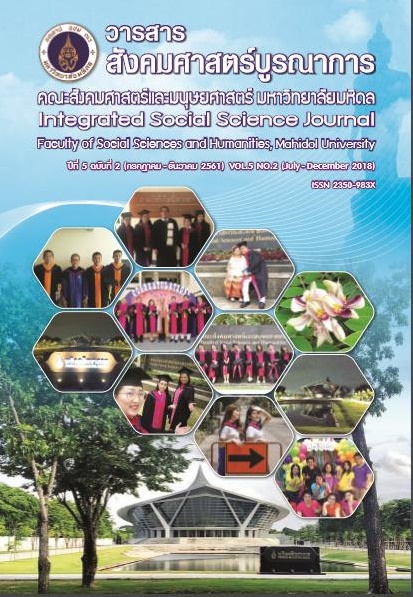การเพิ่มความสามารถด้านมิติสัมพันธ์ของนักเรียนระดับมัธยมศึกษาตอนปลายโดยใช้โปรแกรมการเคลื่อนไหวตาอย่างรวดเร็ว:การศึกษาคลื่นไฟฟ้าสมอง
Main Article Content
บทคัดย่อ
การวิจัยนี้มีวัตถุประสงค์เพื่อเพิ่มและเปรียบเทียบความสามารถด้านมิติสัมพันธ์ของนักเรียนระดับมัธยมศึกษาตอนปลาย กลุ่มตัวอย่างเป็นนักเรียนชั้นมัธยมศึกษาตอนปลาย โรงเรียนแสนสุข จังหวัดชลบุรี จำนวน 59 คน โดยการรับอาสาสมัคร ที่ผ่านการคัดเลือกคุณสมบัติตามเกณฑ์ เครื่องมือที่ใช้เป็นแบบทดสอบความสามารถด้านมิติสัมพันธ์ผ่านโปรแกรมคอมพิวเตอร์ร่วมกับบันทึกคลื่นไฟฟ้าสมอง วิเคราะห์ข้อมูลด้วยสถิติทดสอบที การวิเคราะห์ความแปรปรวนพหุคูณ ผลการวิจัยพบว่า โปรแกรมการเคลื่อนไหวตาอย่างรวดเร็วช่วยทำให้ความสามารถด้านมิติสัมพันธ์ของนักเรียนระดับมัธยมศึกษาตอนปลายเพิ่มขึ้น พิจารณาจากนักเรียนมีความสามารถด้านมิติสัมพันธ์สูงกว่าก่อนได้รับการฝึกและนักเรียนกลุ่มที่ได้รับการฝึกมีความสามารถด้านมิติสัมพันธ์สูงกว่ากลุ่มไม่ได้รับการฝึก แสดงให้เห็นว่าโปรแกรมการเคลื่อนไหวตาอย่างรวดเร็ว ส่งผลความสามารถด้านมิติสัมพันธ์เพิ่มขึ้น
Article Details
- วารสารสังคมศาสตร์บูรณาการ มหาวิทยาลัยมหิดล อนุญาตให้สามารถนำไฟล์บทความไปใช้ประโยชน์และเผยแพร่ต่อได้ โดยอยู่ภายใต้เงื่อนไขสัญญาอนุญาต CC Attribution-NonCommercial-NoDerivatives 4.0 International (CC BY-NC-ND 4.0) โดยต้องแสดงที่มา/การอ้างอิงจากวารสาร – ไม่ใช้เพื่อการค้า – ห้ามแก้ไขดัดแปลงเนื้อหา
- ข้อความที่ปรากฏในบทความในวารสารฯ เป็นความคิดเห็นส่วนตัวของผู้เขียนแต่ละท่าน ไม่เกี่ยวข้องกับกองบรรณาธิการวารสารฯ (ซึ่งหมายรวมถึง บรรณาธิการ ผู้ทรงคุณวุฒิในกองบรรณาธิการ หรือ บรรณาธิการรับเชิญ) แต่อย่างใด ความรับผิดชอบองค์ประกอบทั้งหมดของบทความแต่ละเรื่องเป็นของผู้เขียนแต่ละท่าน หากมีความผิดพลาดใด ๆ ผู้เขียนแต่ละท่านจะรับผิดชอบบทความของตนเอง ตลอดจนความรับผิดชอบด้านเนื้อหาและการตรวจร่างบทความเป็นของผู้เขียน ไม่เกี่ยวข้องกับกองบรรณาธิการวารสารฯ
- กองบรรณาธิการขอสงวนสิทธิ์ในการตัดทอน/ปรับแก้ถ้อยคำบางประการเพื่อความเหมาะสม
เอกสารอ้างอิง
officer Students Using a Saccadic eye Movement Computer training Program: An event-Related Potential Study. Research Methodology & Cognitive Science, 14(2).1-18.
Parinya Ruangtip & Decha Wunnapahool. (2014). A Development Spatial Ability of High
School Students by Sudoku Games. Journal of Rajanagarindra, 11(25).35-42.
Piyawan Tanudtanusilp Suchada Kornpetpanee & Parinya Ruangtip. (2017). Increasing Spatial
Recognition Ability Using Three Dimensional Multiple Object Tracking (3D – MOT) Task for Upper Secondary School Students: An Electroencephalogram Study. Research Methodology & Cognitive Science, 15(1).73-92.
Poliny Ung & Suchada Kornpetpanee.(2017). Development of a Three-Dimensional Multiple-
Moving Block Tracking Model (3D-MBTM) for Enhancing Spatial Ability in Early
Adolescence. Research Methodology & Cognitive Science, 15(2).12-24.
Withawat Penphu & Suchada Kornpetpanee (2017). Enhancing the Visual Perception Ability of
Motorcycle Taxi Riders Using a 3D Motion Object Tracking Training Program. Research
Methodology & Cognitive Science, 15(1). 54-64.
Arce, C., Ramos, J., Guevara, M. A., & corsi-Cabrera, M. (1995). Effect of spatial ability and sex on EEG power in high school students. International Journal of Psychophysiology, 20(1), 11-20.
Barcelo, F. (2003). The Madrid card sorting test (MCST): a task switching paradigm to study executive attention with even-related potentials. Brain Research Protoclls, 11, 18-23.
Brosseaau-Lachaine, O., Gangnon, L., Forget, R., & Faubert, J. (2008). Mild traumatic brain injury induces prolonged visual processing deficits in children. Brain Inj, 22(9): 657-658.
Bhattacharya, J., & Petsche, H. (2002). Shadows of artistry: cortical synchrony during
perception and imagery of visual art. Cognitive Brain Research, 13(2), 179-186.
Combs, D. R., & Gouvier, W. D. (2004). The role of attention in affect perception: An
examination of Mirsky's four factor model of attention in chronic schizophrenia. Schizophr Bull, 30(4), 727-738.
Christman, S. D., & Propper, R. E. (2010). Dreaming,handedness, and sleep architecture:
interhemispheric mechanisms. Int Rev Neurobiol, 9(2), 215-232.
Chowdhury, R., Guitart-Masip, M., Bunzeck, N., Dolan,R. J., & Duzel, E. (2012). Dopamine
modulates episodic memory persistence in old age. J Neurosci,32(41), 14193-14204.
Corsi-Cabrera, M., Arce, C., Ramos, J., & Guevara, M. A. (1997). Effect of spatial ability
and sex inter- and intrahemispheric correlation of EEG activity. Electroencephalography and Clinical Neurophysiology, 102(1), 5–11.
Dukette, D., & Cornish, D. (2009). The Essential 20:Twenty component of an excellent health
careteam. N.p., 72-73.
Edmonds, W. A., & Kennedy, T. D. (2017). An Applied Reference Guide to Research Designs:
Quantitative,Qualitative, and Mixed Methods. Sage Publication.
Gualberto Cremades, J. (2002). The effects of imagery perspective as a function of
skill level on alpha activity. International Journal of Psychophysiology,
43(3), 261-271.
Hasselmo, M. E. (2006). The Role of Acetylcholine in Learning and Memory. Current.
Jausovec, N., & Jausovec, K. (2012). Sex differences in mental rotation and cortical activation
patterns: Cantraining change them? Intelligence, 40(2), 151-162.
Koepp, M. J., Gunn, R. N., Lawrence, A. D., Cunningham, V. J., Dagher, A., Jones, T., Brooks, D. J., Bench, C. J., and Grasby, P. M. (1998). Evidence for striatal dopamine release during a video game. Nature 393: 266–26
Liu, L., Johnson, H. L., Cousens, S., Perin, J., Scott, S., Lawn, J. E., ... & Mathers, C. (2012).
Global, regional, and national causes of child mortality: an updated systematic analysis for 2010 with time trends since 2000. The Lancet, 379(9832), 2151-2161.
Mahncke, H. W., Connor, B. B., Appelman, J., Ahsanuddin, O. N., Hardy, J. L., Wood, R. A., ... &
Merzenich, M. M. (2006). Memory enhancement in healthy older adults using a brain
plasticity-based training program: a randomized, controlled study. Proceedings of the
National Academy of Sciences, 103(33), 12523-12528.
Moore, T., & Fallah, M. (2001). Control of eye movements and spatial attention. Proc
Natl Acad Sci U S A, 98(3), 1273-1276.
Newton, P. (2009) Psychometric success – spatial ability. Retrieved from www.psychometric-success.com
Poe, G. R., Walsh, C. M., & Bjorness, T. E. (2010). Cognitive neuroscience of sleep. Prog Brain
Res, 185(8), 1-19.
Parsons, B., Magill, T., Boucher, A., Zhang, M., Zogbo, K., Bérubé, Scheffer, Beauregard, &
Faubert, J. (2014). Enhancing cognitive function using perceptual-cognitive training.
Clinical EEG and Neuroscience,47(1), 37-47.
Shepherd, M., Findlay, J. M., & Hockey, R. J. (2007). The relationship between eye
movements and spatial attention. The Quarterly Journal of Experimental
Psychology, 38(3), 475-491.
Souto, D., & Kerzel, D. (2011). Attentional constraints on target selection for smooth pursuit eye movements. Vision research, 51(1), 13-20.
Torralba, A., Oliva, A., Castelhano, M. S., & Henderson, J. M. (2006). Contextual guidance of eye movements and attention in real-world scenes: the role of global features in object search. Psychological review, 113(4), 766.
Uttal, D. H., Meadow, N. G., Tipton, E., Hand, L. L., Alden, A. R., Warren, C.
Newcombe, N. S., (2012). The malleability of spatial skills: a meta-analysis of training studies. Psychological Bulletin, 139(2), 352-402.
Wai, J., Lubinski, D., & Benbow, C. P. (2009). Spatial ability for STEM domains:
Aligning over fifty years of cumulative psychological knowledge solidifies its
importance. Journal of Educational Psychology, 101, 817–835.
Van Garderen, D. (2006). Spatial visualization, visual imagery, and mathematical problem solving of students with varying abilities. Journal of Learning Disabilities, 39(6), 496–506.
Zhong, M., Zhao, X., Zou, X.-c., Wang, J. Z., & Wang, W. (2014). Markov chain based
computational visual attention model that learns from eye tracking data.
Pattern Recognition Letters, 49(0), 1-10.


